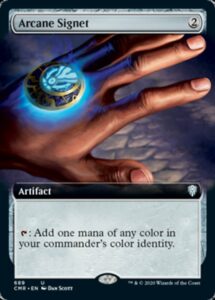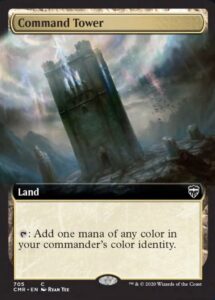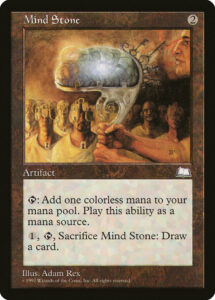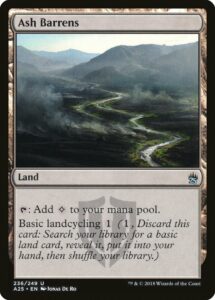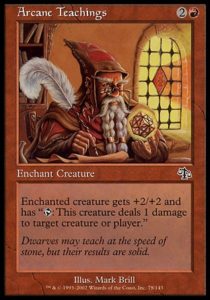Magic’s had a long-running paradigm quietly going in the background. It’s rarely mentioned, but it allows two kinds of designs to inform parallel versions of themselves in future designs. Commander Legends is more overt about this than perhaps any other set; but rather than spell it out immediately, why don’t we play a quick game? I’m going to show some cards that fit the pattern and you try and figure out what that pattern is.
One card isn’t a ton to go by, but I’ll add another hint: not only does Arcane Signet fit the pattern, but it does so doubly in Commander Legends.
…
…
…
Let’s give you one more. Thought Vessel fits the pattern and does so doubly in Commander Legends.
…
…
…
Alright, here’s another one: Simic Signet is in a Commander Legends Commander deck. It fits the pattern, but does not do so doubly in Commander Legends. In fact, Simic Signet can’t do so doubly in any set. But Azorius Signet did so in Commander 2020.
…
…
…
Do you see the pattern yet? Well, here’s your final hint.
Commander Tower and Arcane Signet are the same design, just one is a land and the other’s an artifact with converted mana cost 2. And they’re in the same set, a rarity for these paired designs. Thought Vessel and Reliquary Tower have the same relationship. Azorius Signet stems from Odyssey’s Skycloud Expanse—that cycle never got an enemy colored version, so Simic Signet can never be in the same set as its land version.
Keep digging and you’ll find plenty more. Exotic Orchard is based on Fellwar Stone from The Dark. There’s Prismatic Lens and Shimmering Grotto. Talisman of Indulgence and Sulfurous Springs (or the enemy versions like Talisman of Hierarchy and Caves of Koilos, both of which were made well after their allied antecedents).
If you squint your eyes, you’ll find even more instances of artifacts and lands inspiring each other. There’s no direct land version of Mind Stone, but there is Horizon Canopy. Relic Barrier doesn’t tap for mana, so Blinkmoth Well adds a restriction and a mana cost to compensate for gaining the ability to add mana. Mishra’s Factory and Mutavault are pushing it on power level, so Guardian Idol errs on the lower side. The same thing happened with Reflecting Pool and Star Compass, or Gemstone Mine and Sphere of the Suns.
Unclaimed Territory and Pillar of Origins were first printed in the same set and the pillar got nerfed (and this happened years after the super powerful Cavern of Souls was printed). Rupture Spire is basically the same card as Manalith, since they found a way to give a land a mana cost of 1. And Nephalia Academy takes a cheaper artifact, the old-school Library of Leng, and nabs the ability that Reliquary Tower hadn’t already taken.
There’s certainly quite a bit of difference to how these effects play on lands and artifacts. Lands are more powerful by virtue of not taking up spell slots in your deck and being the hardest permanent type to answer, while artifacts ramp you and have far more synergies to take advantage of. And this trend obviously can’t apply to all lands and CMC 2 artifacts—you can’t slap a mana ability onto Howling Mine or Shrine of Burning Rage, turn it into a land, and call it fair. But it does make one wonder: what future designs could we hope for in this vein?
Several designs come to mind for possible inclusions in future Commander products (or other sets with higher power level, like Modern Horizons). Artifact versions of Ash Barrens and Buried Ruin would likely be weaker than their land counterparts but could support an artifacts-in-graveyard theme alongside cards like Armix, Filigree Thrasher. If there’s another Planechase product, I’d expect to see a land version of Fractured Powerstone (that perhaps had a cost of 1 to activate). I’m frankly surprised we haven’t gotten an artifact version of Radiant Fountain yet and wouldn’t be shocked if there’s a Homeward Path or resuable Command Beacon on a future artifact. There could be a land version of Magewright’s Stone with a more expensive activation—sure, it wouldn’t take much for it to go infinite with an Argothian Elder, but Wirewood Lodge already exists.
Having researched every land and most cheap artifacts for this article, the card I’d be most excited to see is an artifact version of is Ancient Tomb. Worn Powerstone is a ludicrously powerful cube card; but I think some Legacy cubes could accommodate this dangerous bargain, and it’s not as though Sol Ring isn’t one of the most played cards in Commander. It could be a fun and skill-testing introduction in Cube and Commander and possibly allow different kinds of Legacy decks than Grim Monolith currently enables.
The land <–> 2CMC artifact paradigm is but one pattern among many in Magic design. There are the Shocks with set mechanic; the iconic spells stapled onto creatures as enters-the-battlefield abilities or as Planeswalker ultimates; the enchantments that trigger when you do one thing and give you a Shocks or card draw in return; and the 3/1s for 1W that find ways to turn trinket text, card typing, and flavor text into a window into a plane.
These patterns give us a window into how game design works (it’s about finding the right balance between familiarity and innovation) and the people who do it (it’s a lot easier to mine familiar design space than to constantly uncover rich new veins). I always enjoy seeing how the past and future inform each other and trying to guess at the future based on what came before. Perhaps you do, too; and perhaps you might now have an idea of a card you’d like to see in the future you didn’t know you’ve long since wanted.
And, as always, thanks for reading.
—Zachary Barash is a New York City-based game designer and the commissioner of Team Draft League. He designs for Kingdom Death: Monster, has a Game Design MFA from the NYU Game Center, and does freelance game design. When the stars align, he streams Magic (but the stars align way less often than he’d like).

